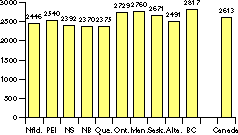
Health care spending: Sunnier days ahead?
CMAJ 1999;160:16
© 1999 Canadian Medical Association
Based on November estimates from the Canadian Institute for Health Information, spending on health care reached $77.1 billion in 1997 and $80 billion in 1998. Spending within the public sector increased by 3.7%, a dramatic increase over the previous 4 years when these increases averaged only 0.7% a year.
The private sector — this includes private insurance and out-of-pocket costs — continues to grow in importance, accounting for an estimated 30.3% of total health care spending in 1998, or $792 per capita. The private sector accounts for only 1.2% of total spending on physician services but for more than 90% of spending on "other professionals" and for over 68% of all drug expenditures.
The 1998 estimates indicate that the largest annual percentage increase in per capita spending occurred in Newfoundland (4.9%), while Prince Edward Island experienced a decrease of 0.7%. Alberta continues to spend the least on health care as a percentage of provincial GDP — 7% in 1998. Newfoundland spends the most, 12.3%.
| ||||||
Spending increased in all categories except capital expenditures, an area that has recorded decreases for the last 4 years. A downward trend in hospital spending that began in 1994 appears to have ended, with a 0.4% increase in spending in 1997 and an estimated jump of 3% in 1998. Spending on nonphysician professionals showed the largest increase in 1997 (5.1%) while spending on drugs experienced the biggest increase in 1998 (5.9%).
This column was written by Lynda Buske, chief, physician resources information planning, CMA. Readers may send potential research topics to Patrick Sullivan (sullip@cma.ca; 613 731-8610 or 800 663-7336 x2126; fax 613 565-2382).
|
|
Send a letter to the editor Envoyez une lettre à la rédaction |
Autres chroniques Médicogramme |

